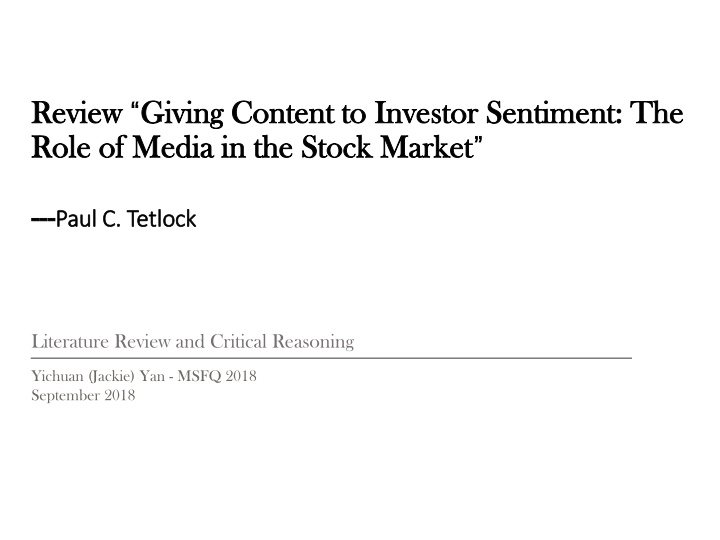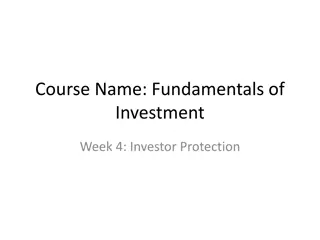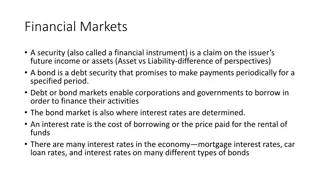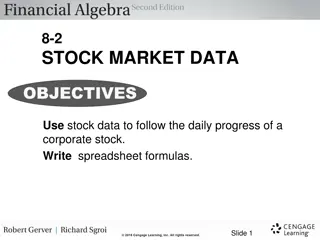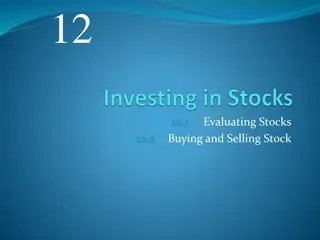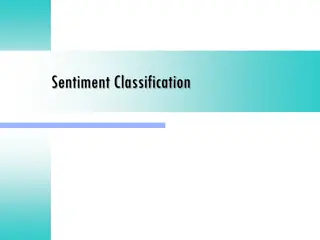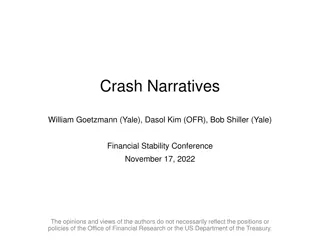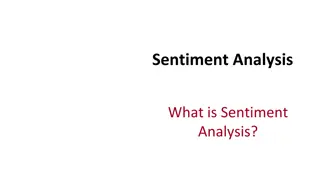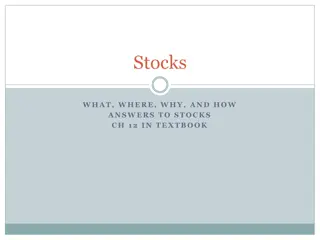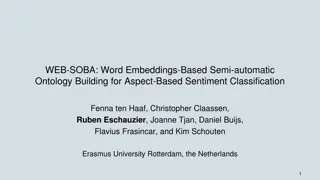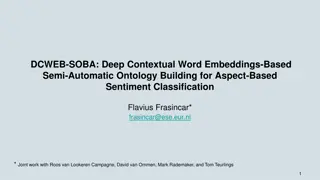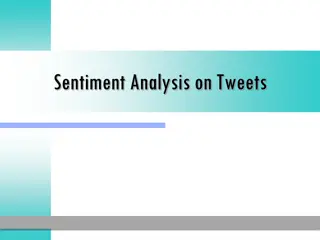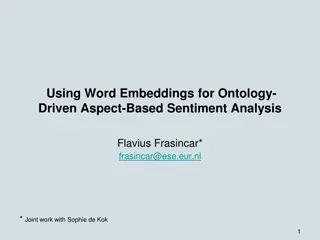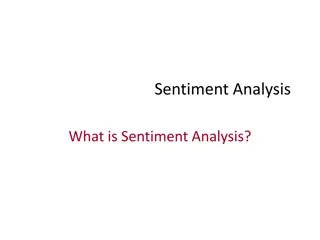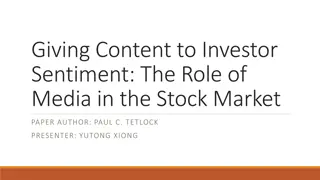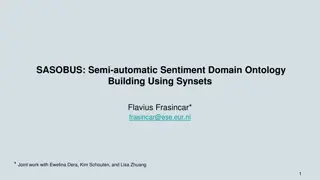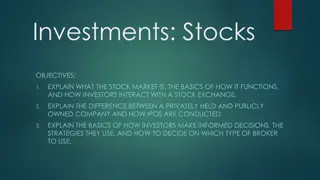Media Influence on Investor Sentiment and Stock Market Behavior
This literature review by Paul C. Tetlock explores the role of media in shaping investor sentiment and impacting stock market dynamics. The study delves into the correlation between media pessimism, market prices, trading volume, and volatility, providing insights into how media content affects market behavior. Using data analysis techniques such as PCA and VARs, the research examines the intertemporal links between media sentiment and stock market performance.
Download Presentation

Please find below an Image/Link to download the presentation.
The content on the website is provided AS IS for your information and personal use only. It may not be sold, licensed, or shared on other websites without obtaining consent from the author.If you encounter any issues during the download, it is possible that the publisher has removed the file from their server.
You are allowed to download the files provided on this website for personal or commercial use, subject to the condition that they are used lawfully. All files are the property of their respective owners.
The content on the website is provided AS IS for your information and personal use only. It may not be sold, licensed, or shared on other websites without obtaining consent from the author.
E N D
Presentation Transcript
Review Review Giving Content to Investor Sentiment: The Giving Content to Investor Sentiment: The Role of Media in the Stock Market Role of Media in the Stock Market --- ---Paul C. Tetlock Paul C. Tetlock Literature Review and Critical Reasoning Yichuan (Jackie) Yan - MSFQ 2018 September 2018
Executive Summary Background Paper: Introduction & summary (w comments) Previous theories (w comments) Methods & reasoning (w comments) (Additional) findings & conclusions (w comments) Next steps Questions 2
Irrelevance Professor Paul C. Tetlock https://www0.gsb.columbia.edu/faculty/ptetlock/research.html Sentiment & media Power of the words Market efficiency Systematic or discretionary (how should you value it) 3
Introduction C1: High media pessimism robustly market prices followed by a reversion to fundamentals. C2: Unusual Unusual high or low pessimism predicts high market trading volume. C3: C1 and C2 are consistent with theoretical models of noise and liquidity theoretical models of noise and liquidity traders traders, and are inconsistent with theories of media content theories of media content as a proxy for new information about fundamental asset values, as a proxy for market volatility, or as a sideshow with no relationship to asset markets. robustly predicts downward pressure on market volume volatility media pessimism media pessimism market returns Asset fundamentals 4
Introduction (cont.) U.S. Stock market s returns Wall Street Journal s (WSJ s) Abreast of the Market U.S. Stock market s volumes U.S. Stock market s volatilities 5
Introduction (cont.) General Inquirer (GI) is used to analyze daily variation in the column for 16 years; PCA is used to construct a measure of media pessimism as pessimism factor. Wall Street Journal s (WSJ s) Abreast of the Market Vector autoregressions (VARs) are used to estimate the intertemporal links between this measure of media pessimism and the stock market s returns, volumes, volatilities, etc. 6
Comments Chicken first or egg first? Do people tend to post negative views more often than positive or no view? Or, do people use more intense words for negative views than the others? Classify people who have views? Why PCA? 7
Previous Theories on the Effects of Sentiment on Stock Market Low sentiment will generate downward price pressure and unusually high or low values of sentiment will generate high volume DeLong et al. (1990a) Changes in the level of risk aversion for a large subset of investors can affect short-term returns. To distinguish noise and liquidity trader theories is to interpret the media pessimism variable for either sentiment of risk aversion Campbell, Grossman, and Wang (1993) Media pessimism should have no effect on future market activity. WSJ s Abreast of the Market is made to entertain readers. No information conveyed. Unknown source The media pessimism measure is a proxy for negative information about the fundamental values of equities that is not currently incorporated into prices. Unknown source 8
Previous Theories (cont.) Noise traders: hold random beliefs about future dividends Two types of traders exist: Define Pessimism Rational arbitrageurs: hold Bayesian beliefs Two key assumptions Both types of traders are risk-averse and capital constrained An equilibrium: noise traders random beliefs about future dividends influence prices. More specifically, noise traders sell stocks to arbitrageurs, increase the volume, and temporarily depress the returns; in the next period, when a new belief comes in, returns rebound. 9
Previous Theories (cont.): what this paper is about This paper tests the specific hypothesis that high media pessimism is associated with low investor sentiment, resulting in downward pressure on prices. It is unclear whether media pessimism forecasts investor sentiment or reflects past investor sentiment. 10
Previous Theories (cont.): the most likely scenario 11 Highly Confidential
Comments Information theory and sentiment theory? Why (only) choose WSJ? 325,000 professionals; accessible electronic version. 12
Methods and Reasonings: generating the pessimism media factor General Inquirer (GI) counts the number of words in each day s column that fall within various word categories, defined by Harvard IV-4 psychosocial dictionary. To minimize semantic and stylistic noise in the column, all GI categories is re-centered so that their conditional means are equal across different days of the week. Day-of-the-week dummy variables are used. PCA is used to extract the most important semantic component from the (77 x 77) variance-covariance matrix of the categories in the Harvard dictionary and makes the component a pessimistic factor. Negative, Weak, Weak, Fail, Fall. Negative, PCA: https://stats.stackexchange.com/questions/2691/making-sense-of- principal-component-analysis-eigenvectors-eigenvalues 13
Methods and Reasonings: generating the pessimism media factor Is time variation in the GI categories stable? 14
Comments? Alternative approaches to select the categories? Tree-based methods? Lasso/Ridge? Could such strong correlation continue or subject to a regime shift? 15 Highly Confidential
Methods and Reasonings: market activity and pessimism Vector autoregressive (VAR) Returns, volume, pessimism factor Robustness and sensitivity Still valid given a change? Economic importance Any profitable trading strategy? This study controls for the influence of the lagged returns of indices and lagged returns of any larger indices. Regressions also include lagged volume to try to capture liquidity effects. 16
Methods and Reasonings: VAR estimates Vlm: detrended daily volume on the NYSE SMB: Fama and French daily small-minus-big factor Dow: daily returns on the Dow Jones Industrial Average BdNws: the pessimistic media factor L5: [Xt-1 Xt-2 Xt-3 Xt-4] five lags Exog: the exogenous variables include five lags of the detrended squared Dow residuals that proxy for past volatility, dummy variables for day-of-the- week and January that control return anomalies, and a dummy variable for Oct. 19th stock market crash 17
Methods and Reasonings: VAR estimates - returns 18 Highly Confidential
Methods and Reasonings: VAR estimates - conclusions The negative sentiment has a significant temporary impact on future Dow Jones returns that is fully reversed within one week. A decrease in return causes an increase in negative sentiment. Rejects the theories of media pessimism as a proxy for trading costs; agrees with the theories of pessimism as a proxy for sentiment (Camplbell et al. (1993) and DeLong et al. (1990a)). Negative sentiment seems to have a longer-lasting and larger impact on small stocks. (comment) 22
Why to Test Robustness? What if the afternoon WSJ contains late-breaking information not completely incorporated in closing prices, then investors continue to react to news on the next trading day? Although theories of media content as a proxy for information about fundamental asset values could be consistent with some of the regression results we get, these theories do not allow the existence of noise and liquidity traders that do exist in reality. 23
Methods and Reasonings: robustness and sensitivity analysis The question here is whether the pessimism factor is concentrated in after- hours and opening hours returns or is dispersed uniformly throughout the trading day. Lag is applied: use a return window that begins on 10 a.m. the day after the column is released on the newswires; control variables are added to capture the influence of closing and opening returns and volume. 24
Methods and Reasonings: robustness and sensitivity analysis 25
Methods and Reasonings: robustness and sensitivity analysis 26
Methods and Reasonings: robustness and sensitivity analysis 27
Methods and Reasonings: robustness and sensitivity analysis From the similarities between all the tables presented, it appears that the market response to pessimism is dispersed throughout the following trading week. It is likely that much of the immediate response to true information contained in the column has already occurred even before the column has been written. == column is written before the end of the prior trading day. However, there is another hypothesis: market valuations during the bull market of the 1990s were affected by irrationally exuberant traders. The sentiment measures examined should exert a larger impact during the second half of the sample. Depending on the size of the transaction, costs attributable to bid-ask spreads and finite market depth may exceed 4.4 basis points per trade the cutoff value for eliminating the profitability of a pessimism-based trading strategy. 28
Methods and Reasonings: robustness and sensitivity analysis 29
Methods and Reasonings: robustness and sensitivity analysis By far, everything is from parametric estimates. What if we use a semi- parametric estimate? For a nonparametric estimate of the effect of negative sentiment on this residual Dow return with a standard locally weighted regression Omitting only the lags of the negative sentiment measures from the linear regression, to obtain an estimate of the unexplained residual daily Dow return Pessimism media factor, Negative words Category, and the Weak words category 30
Methods and Reasonings: economic important of the results IF Negative words are in the bottom third of the prior year s Negative word distribution IF Negative words are in the top third of the prior year s Negative word distribution Benchmark Benchmark THEN borrow at the riskless rate to purchase all the stocks in the Dow Jones Index and sell them back one day later THEN borrow all the stocks in the Dow Jones index, receiving the risk- less rate, and buy them back one day later 32
Methods and Reasonings: economic important of the results Buys the index 1,281 times and sells the index 1254 times in the 3,700+ trading days between 1985 and 1999 The average daily return of this zero-cost strategy is 4.4 basis point, which is slightly larger than the average daily excess return on the Dow Jones itself The annualized return of the pessimism-based strategy is 7.3% Depending on the size of the transaction, costs attributable to bid-ask spreads and finite market depth may exceed 4.4 basis points per trade the cutoff value for eliminating the profitability of a pessimism-based trading strategy. 33
Conclusions C1: High media pessimism robustly predicts downward pressure on market prices followed by a reversion to fundamentals. C2: Unusual high or low pessimism predicts high market trading volume. C3: C1 and C2 are consistent with theoretical models of noise and liquidity traders, and are inconsistent with theories of media content as a proxy for new information about fundamental asset values, as a proxy for market volatility, or as a sideshow with no relationship to asset markets. 35
Additional Findings Price impact of pessimism appears especially large and slow to reverse itself in small stocks == sentiment theory (media content is linked to the behavior of individual investors) The changes in market returns that follow pessimistic media content are dispersed throughout the trading day, rather than concentrated after the release of information. The negative returns following negative sentiment are reversed over the next few days of market activity. Pessimism strongly predicts market volatility. A sentiment-based trading strategy guarantees high return. 36
Next Steps Profit vanished? S&P500 or Russell 2000? Regime shift since 2007? Crash? Inputs? Returns? Macro-level to micro-level? Deep learning models? 37
Larger takeaways Alpha is a zero-sum game Competitive Predictability battle You want your action to be less predictable Data Trash in, trash out 38
Questions? 39
Thank You 40
